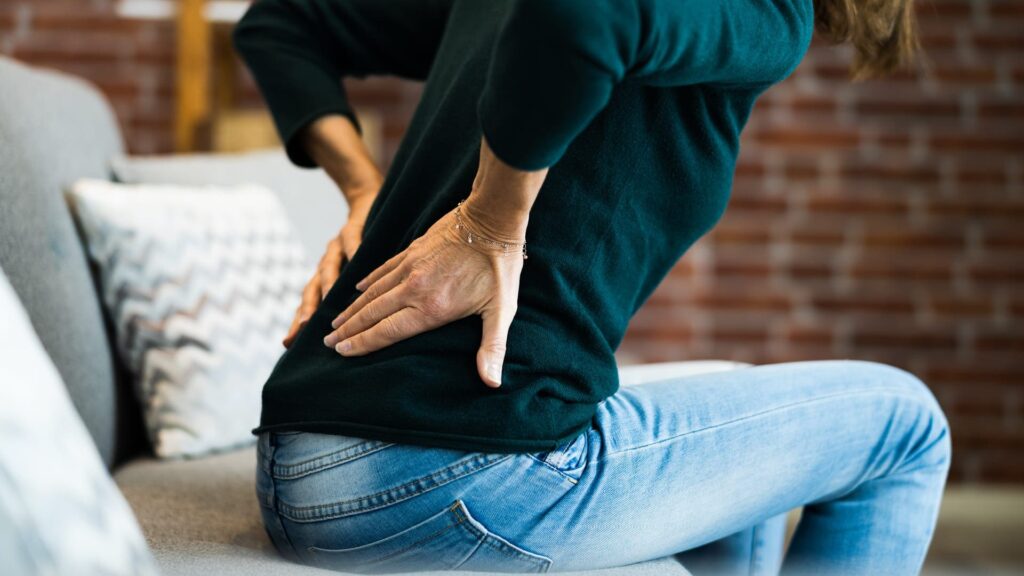One of the most frequent causes of visiting the doctor is lower back pain. It may result from muscle strain, tendons in the back, arthritis, structural problems, or disk injuries. By staying active and maintaining a healthy weight, you can reduce the risk of back pain.
REASONS YOU MAY HAVE A STIFF BACK
- A tight muscle in the hips and thighs
Hamstrings : Your hamstrings pass across the back of both thighs. They can become tight for various reasons such as physical inactivity. Hamstrings become shorter when they are tight. The alignment of your spine with your pelvis may be disrupted as a result of these changes to the lower part of your spine’s curvature (hip) and you feel stiffness in your lower back.
Targeted hamstring stretching can gradually lengthen your hamstrings and ease lower back tightness.
Hip flexors : Stiffness in the parts of your spine may result from tightness in the iliopsoas muscle, which lifts and brings your thigh close to your body. Spinal instability may occur if iliopsoas tightness is severe. Additionally, the tissues around the spinal column could become irritated and inflamed, resulting in pain.
Stretches that lengthen the hip flexors can reduce pressure on the spine.
- Inflammatory muscles
Ankylosing Spondylitis : Spinal inflammation that results in a fusion between adjacent vertebrae is called ankylosing spondylitis. It causes stiffness and chronic pain in the back. With exercise, the stiffness can get better.
Osteoarthritis : The cartilage in our joints, which serves as a cushion and lubricant where the bones touch and move against one another is affected by osteoarthritis. Osteoarthritis causes inflammation and severe pain by slowly destroying the cartilage between the joints.
The stiffness usually begins in the morning, decreases with activity during the day, and returns to its peak after extended periods of inactivity or rest.
Medications, exercises, and lifestyle changes can be used to treat spinal osteoarthritis and ankylosing spondylitis.
- Sitting with the spine bent forward
If you sit for a long time, pressure increases within each spinal segment, resulting in decreased back strength. For example, the strain on your spine is increased when you sit on the edge of your chair, which can result in stiffness and pain.
It is advised, always sit in an upright posture.
- Dehydration and shrinkage of spinal discs
Spinal discs act as shock-absorbing pads that distribute loads within the spine. These discs can degenerate due to age-related changes. As a result, there is a breakdown in its fibrocartilage component, loss of water, and a decrease in its height. These changes cause spinal stiffness.
Physical therapy, exercise, and medications are used to treat spinal discs.
- Sciatica
Inflammation in the nerve root, which originates in the spine, causes sciatic nerve pain. Treatment depends on the severity and cause of nerve pain inflammation. Medications, physical therapy, or injections may be prescribed to you.

WHAT ARE THE RISK FACTORS FOR BACK PAIN?
Some factors that increase the risk of pain are given below-
- Back pain is more common after 30 or 40 years of age.
- Lack of exercise also leads to back pain.
- A heavy body puts extra strain on the back.
- Both cancer and arthritis can result in back pain.
- The risk of back pain is higher for smokers.
- Improper lifting also leads to back pain.
AT-HOME REMEDIES FOR BACK PAIN
- Ice : By constricting blood vessels, ice can numb the pain and reduce inflammation.
- Heat : Heat can relax muscles and relieve joint pain by increasing blood flow.
- Light activity : Keep moving gently as much as you can as bedrest can worsen back pain.
- Pain relievers : Over-the-counter NSAIDs (nonsteroidal anti-inflammatory drugs) such as ibuprofen or naproxen can relieve back pain and stiffness.
- Relaxation methods : Medication, and deep breathing relaxes back muscles and decreases stiffness and pain.
- Massage : Massage can help relieve stiffness in the back muscles.

VISIT SPECIALTY CARE CLINICS IF:
- Back pain lasted for more than a couple of weeks.
- Back stiffness hinders daily activities.
- Back pain or stiffness is severe in the morning.
- You experience pain and stiffness in muscles or joints.
- You have been diagnosed with arthritis or other conditions.
- Your symptoms are worsening.
Seek medical treatment right away if you face these symptoms along with pain or stiffness:
- Change in vision
- Fever
- Unusual fatigue
- Inability to control bowel or bladder function
HOW TO PREVENT BACK PAIN?
Lower back pain caused by illness or structural issues with the spine cannot be prevented. However, back injuries are preventable.
- Maintain a healthy weight : Extra weight puts pressure on the spine
- Exercise : Regular low-impact aerobic exercise can improve back strength and endurance and the efficiency of the muscles. You should also consider swimming or walking.
- Quit smoking : Back pain is more likely to occur if you smoke.
- Lift correctly : Lift with your legs only, never with your back. Hold anything that weighs a lot close to your body.
Regardless of treatment, lower back pain and stiffness usually get better with time. You can use a variety of self-care steps to treat your stiff back. If stiffness still persists, call Specialty Care Clinics.
